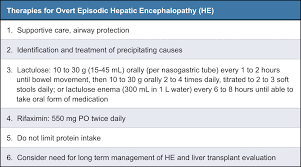The nurse is caring for a client who has ascites and hepatic encephalopathy. Which of the following prescriptions should the nurse clarify with the primary healthcare provider (PHCP)?
Rifaximin
Lactulose
Spironolactone
Alprazolam
The Correct Answer is D
Choice A rationale: Used in the management of hepatic encephalopathy by reducing the production of ammonia in the gut.
Choice B rationale: Often prescribed to reduce ammonia levels in hepatic encephalopathy by promoting bowel movements and aiding ammonia excretion. Choice C rationale: Typically used in managing ascites by reducing fluid retention and treating edema.
Choice D rationale: This medication can potentially worsen hepatic encephalopathy due to its sedative effects and impact on mental function. It's crucial to clarify its use in a patient with hepatic encephalopathy.

Nursing Test Bank
Naxlex Comprehensive Predictor Exams
Related Questions
Correct Answer is A
Explanation
Choice A rationale: Considering the mechanism of injury, pain severity, tenderness, swelling, and ecchymosis, there is a high suspicion of a fracture. Immobilization is essential to prevent further injury and reduce pain.
Choice B rationale: Contracture is less likely in this acute injury scenario. Acetaminophen might manage pain, but it doesn't address the risk factor.
Choice C rationale: A sprain is less likely given the severity of pain and the mechanism of injury. Raising the leg doesn't address the risk of a suspected fracture.
Choice D rationale: Dislocation doesn't align with the reported symptoms. Applying heat could potentially worsen inflammation.
Correct Answer is C
Explanation
Choice A rationale: This is a general description of an imaging test, such as an X-ray, ultrasound, or MRI, which can show the structure of the organs but not the mucosal lining.
Choice B rationale: This is a general description of a blood test, which can show signs of infection, inflammation, or anemia, but not the cause of these problems.
Choice C rationale: This exam is called a colonoscopy, which involves inserting a flexible tube with a camera and light into the anus and advancing it through the colon. A colonoscopy can reveal signs of inflammation, ulcers, bleeding, or narrowing of the intestinal wall that are characteristic of Crohn's disease. A biopsy can also be taken during the procedure to confirm the diagnosis.
Choice D rationale: This is a general description of a urine test, which can show signs of kidney problems, urinary tract infections, or dehydration, but not Crohn's disease.
Whether you are a student looking to ace your exams or a practicing nurse seeking to enhance your expertise , our nursing education contents will empower you with the confidence and competence to make a difference in the lives of patients and become a respected leader in the healthcare field.
Visit Naxlex, invest in your future and unlock endless possibilities with our unparalleled nursing education contents today
Report Wrong Answer on the Current Question
Do you disagree with the answer? If yes, what is your expected answer? Explain.
Kindly be descriptive with the issue you are facing.
